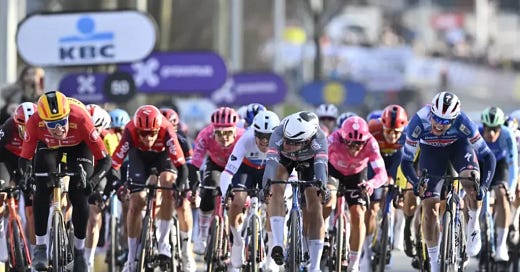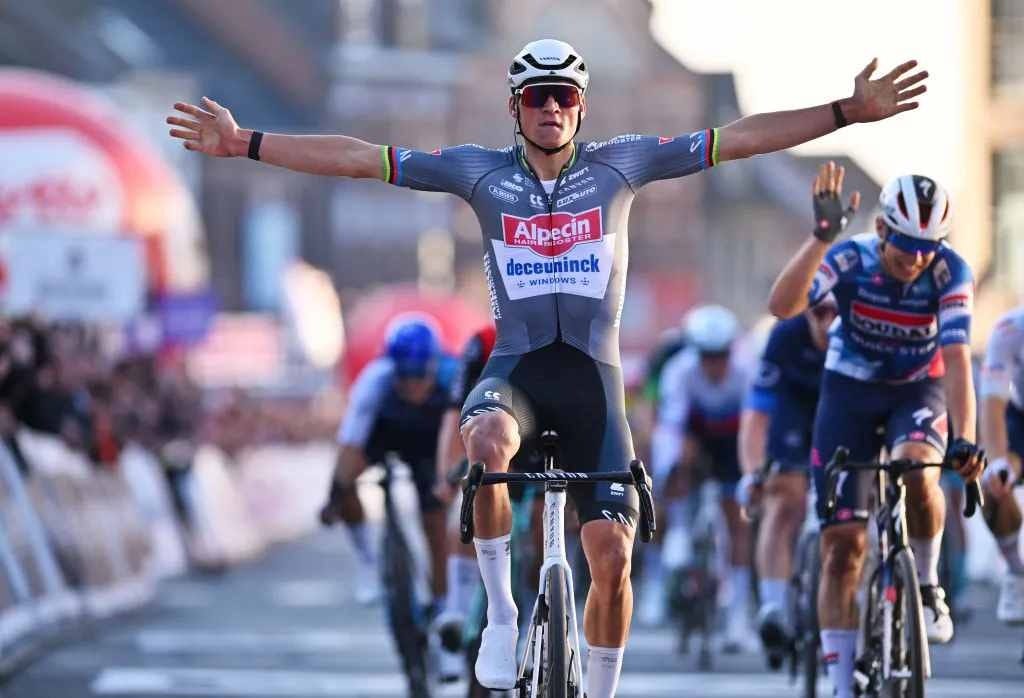7 conclusions from the Cobblestone Triptych*
Waerenskjold, Philipsen, and Van der Poel take the first 3 cobbled classics of the season in a disappointing Opening Weekend.
This was supposed to be a recap of what happened during the Opening Weekend, but a big asterisk in the form of a former world champion made me change my plans and include a third race here, the Ename Samyn Classic, as part of this first analysis of Belgian spring classics.
Mathieu Van der Poel decided to race Le Samyn at the last minute. And if he changes everything he races, how could I not change my plans?
1. A disappointing weekend
The first conclusion has to do with the development of the races. Despite Kuurne typically being a race decided by a sprint, although that hasn't been the case in the last two years, in Omloop it's much more common to see attacks and counterattacks, especially when the participation is so high and there isn't an overwhelming favourite like Pogacar or Van der Poel, and the logical outcome would have been a finish between a very small group.
Instead, the race lacked significant movements, and despite some tactical accelerations by UAE around 90km from the finish, followed by Visma and, especially, by Alpecin, the key attacks were reduced to Tarling's attempt and, later, Küng's solo effort with the headwind, which made many hesitate to push further. Are we seeing a shift in trends due to the rise of sprinters who can handle the cobbled climbs like De Lie, Magnier, Groves, or Philipsen?
2. Alpecin is the dominant team in these races
Even with the absence of Van der Poel, the Groves-Philipsen duo entered the Opening Weekend with a relative favouritism, mainly focused on Kuurne.
Once Narváez, De Lie, and Van Aert were dropped in Omloop, the Belgian team took control of the race, immediately eliminating De Lie and wearing down their other two major rivals. Philipsen couldn’t finish off in a disappointing sprint, where he had much more headwind than the top two, but he got the victory in Kuurne thanks to Groves' perfect leadout. Clean, undisputed, and head-to-head with Kooij, Milan, and Merlier. His first win of the year at the best possible time. Though, as Cillian Kelly reminds us, and even if it’s just a side note, not winning in Omloop still guarantees opportunities later on.
3. Van Aert is not on form
It’s evident and his struggles in Jaén and Algarve were confirmed during the Opening Weekend. In Omloop, he was poorly positioned during almost every key moment, was dropped in the key moment, and then took on the responsibility of chasing down the group. He spent too much energy and was far from competing in the final sprint.
Kuurne was a different story... Although we saw the same old tale: Van Aert chasing and swimming against the tide. That said, his move alongside Roger Adrià, on his second attempt of the day, was a bolder idea than what’s been discussed afterwards. There were 9 riders ahead, including Tim Wellens, and many teams keen to avoid a near-certain sprint. Adrià perfectly marked Van Aert, but stuck to team orders and didn’t take a turn at the front. Adrià is fast, clever, and showed he’s ready for these races. Why wasn’t he given more freedom? Did Red Bull overestimate their chances with Jordi Meeus?
4. Superteams under scrutiny
Visma placed too much faith in Van Aert's chances and, in the absence of Laporte, relied on Jorgenson as a lieutenant in Omloop and on Kooij's option in Kuurne. The reality is, not much remains of the team that took 3 consecutive wins in Omloop with 3 different riders or that dominated the race scenarios in Kuurne in the past two years. I didn’t understand Jorgenson’s role, and maybe his hierarchy needs to be reassessed for RVV.
UAE's weekend was even worse. It's a team where, much like in stage races, it’s crucial to stand out when the opportunity arises, meaning in the absence of the King. And despite arriving with a fantastic squad full of riders with potential, they were powerless against teams like Alpecin, and their weekend was limited to Wellens' attempt in Kuurne at the same point where Van Aert went off with him and Lazkano last year. Narváez lost two golden opportunities, as did Morgado. They won’t have many more.
Red Bull, on the other hand, was a complete disaster. A mechanical before tackling the Kapelmuur ruined Tratnik's title defence, poor tactics kept Adrià from dreaming of anything more in Kuurne, and Tim van Dijke did a decent job neutralising Van Aert's attempt before Küng's attack, but little else. Too conservative in a team whose main strength was the wide variety of options they had. Too much faith in Meeus... and too little from Lazkano, who needs to improve significantly.
5. Uno-X is not a second division team
It seems unbelievable that, due to invitations and national quotas, this team could miss out on the Grand Tours in 2025. Abrahamsen closed gaps and Søren Wærenskjold finished it off. Easy, right? Although they weren’t the favourites, their race was sobriety and intelligence, and they took the first World Tour title in Europe of the year.
In Kuurne, Wærenskjold showed signs of fatigue, not sure if physical or emotional, and they wrapped up the Triptych with a strong finish by Stian Fredheim in Le Samyn (6th). A team that is desperately asking to be part of the major races on the calendar.
6. Magnier is a huge rider
The Frenchman has a lot of noise around him, and I believe the ‘new Boonen’ label doesn’t help. That weighs heavily. But the reality is, every day that passes, he insists on proving that the future of this type of race belongs to him.
He’s powerful, he’s fast, he glides over the cobblestones, and in Soudal, they are once again making headlines in the Flemish cobbled classics thanks to this young guy. He hasn't left the podium in the 5 days of competition he's had so far, finishing 2nd in Omloop, where he lacked just a few metres to complete the comeback, and 2nd in Le Samyn behind Van der Poel, although with a whole bike gap over the third, Jeannière.
He has everything to succeed, starting with time. And what a coincidence, he’ll turn 21 the day after Paris-Roubaix. I’m just saying.
7. What’s going on, Arnaud?
De Lie seems out of form and far from the version that stunned us during the Opening Weekend two years ago (2nd in Omloop, 7th in Kuurne). He lost his spring last year due to illness, and this is a decisive year for him.
In Le Samyn, he also couldn’t contend for victory in a finish that seemed favourable for him on paper. He needs to improve... and Lotto too.
7+1 MVDP
Van der Poel deserves a category of his own.
His participation in Le Samyn caught us by surprise, but it was a joy and another reason to watch one of the most special classics of the year in its 1.1 category. He tried at 65 km to go and again at around 50 km to “prepare the legs for the sprint”, as he said later. A perfect finish, which, with the climb towards the line, cleared any competition from Magnier.
A showcase of his style, a cyclist who is nothing like that wild rider who attacked without calculating his effort, whether in Kuurne or a World Championship. He has 1 hour of effort that only Pogacar and Evenepoel can look in the eye, and a burst of watts that I don't think needs highlighting at this point. He wants his fourth RVV... And in Le Samyn, he laid the first stone of his throne. Veni, vidi, vici.





